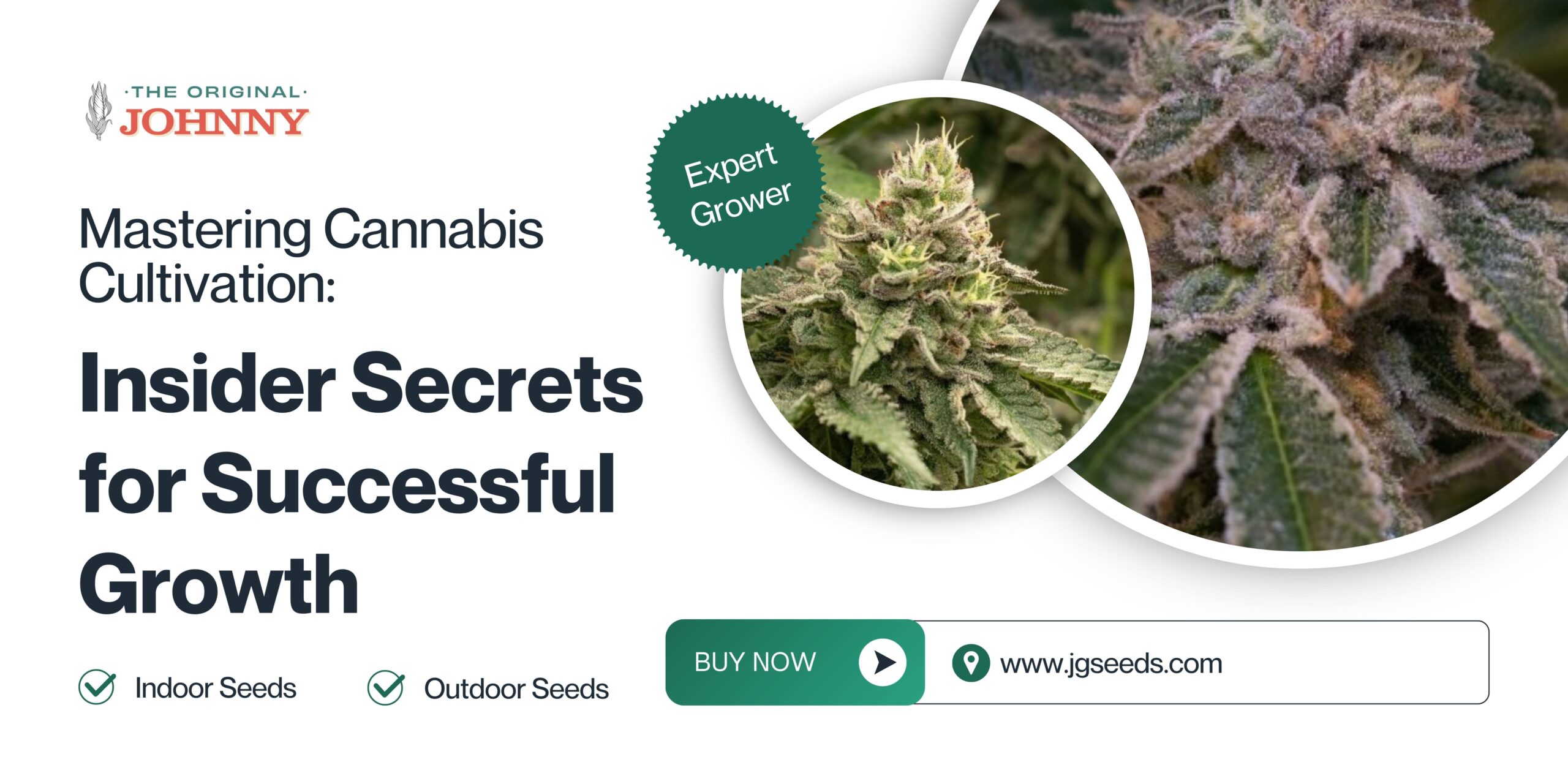Welcome to the world of cannabis cultivation! In this guide, we will delve into the intricate art of growing cannabis plants, exploring insider secrets that can lead to successful cultivation. Whether you are a novice looking to start your own home garden or an experienced grower aiming to refine your techniques, mastering cannabis cultivation is both a science and an art. From selecting the right strains to understanding optimal growing conditions and implementing advanced cultivation methods, this topic covers a wide array of essential information. Get ready to unlock the secrets that can elevate your cannabis cultivation game to the next level. Join us on this journey as we uncover the strategies, tips, and tricks that can help you achieve bountiful yields and top-quality buds. Let’s embark on this exciting adventure together and discover the keys to successful cannabis growth!

Choosing the Right Strain
Understanding the Different Types of Strains Available
When it comes to cultivating cannabis, one of the most crucial decisions you’ll make is choosing the right strain. With countless options available in today’s market, it’s essential to understand the different types of strains and their unique characteristics. From Indica to Sativa and hybrid strains, each offers distinct effects and benefits. By knowing the differences between these types, you can select a strain that aligns with your cultivation goals and preferences.
Factors to Consider When Selecting a Strain for Cultivation
Selecting the ideal strain for cultivation involves considering various factors to ensure a successful harvest. Factors such as the plant’s growth characteristics, flowering time, yield potential, cannabinoid profile, and terpene content play a significant role in determining the suitability of a strain for your cultivation setup. Additionally, factors like climate compatibility, space requirements, and cultivation experience should also be taken into account when choosing a strain to grow. By carefully evaluating these factors, you can make an informed decision and choose a strain that meets your specific needs and preferences.
Popular Cannabis Strain Families
Apart from the distinction between indica, Sativa, and hybrid strains, cannabis can be further categorized into specific families based on genetic lineage. Some popular strain families include:.
-
Kush Strains : Known for their relaxing and sedative effects, Kush strains are favored for their potent cannabinoids and distinct flavors.
-
Haze Strains : Haze strains are renowned for their uplifting and energizing effects, making them ideal for daytime use.
-
Diesel Strains : Diesel strains are characterized by their pungent aroma and often deliver a cerebral high combined with physical relaxation.
-
Cookies Strains : Cookies strains are famous for their sweet and dessert-like flavors, often inducing a calming yet euphoric experience.
Personalizing Your Cultivation Experience
When selecting a strain for cultivation, it’s essential to consider your personal preferences and desired effects. Whether you’re aiming for pain relief, relaxation, creativity, or energy, there’s a strain that can cater to your needs. Additionally, experimenting with different strains allows you to discover unique combinations of cannabinoids and terpenes that suit your individual preferences.
Conclusion
Choosing the right strain for cultivation is a crucial step in achieving a successful harvest. By understanding the different types of strains available, considering essential factors, exploring various strain families, and personalizing your cultivation experience, you can cultivate cannabis that meets your expectations and preferences.
Setting Up the Ideal Growing Environment
When it comes to cultivating plants, setting up the ideal growing environment is crucial for the success of your garden. Whether you’re growing plants indoors or outdoors, factors such as light, temperature, humidity, and ventilation play a significant role in the health and growth of your plants.
Importance of Light
Proper lighting is essential for photosynthesis, the process by which plants convert light into energy. Different plants have varying light requirements, so it’s important to consider the light needs of the specific plants you are growing. For indoor cultivation, you may need to supplement natural light with grow lights to ensure your plants receive an adequate amount of light.
Temperature and Humidity
Maintaining the right temperature and humidity levels is crucial for plant growth. Most plants thrive in temperatures between 65-75°F, but it’s important to research the specific temperature requirements of the plants you are growing. Humidity levels also play a role in plant health, with some plants requiring higher humidity levels than others. Using a hygrometer can help you monitor and adjust humidity levels accordingly.
Ventilation
Proper ventilation is essential for ensuring a constant supply of fresh air to your plants. Good air circulation can help prevent issues such as mold, mildew, and pests. In indoor cultivation setups, using fans or an exhaust system can help maintain proper air circulation.
Tips for Indoor and Outdoor Cultivation Setups
When setting up an indoor cultivation space, consider factors such as the location of your plants, the type of containers used, and the layout of your grow space. Make sure to provide adequate spacing between plants to allow for proper air circulation. For outdoor cultivation, consider factors such as sun exposure, soil quality, and protection from harsh weather conditions.
Additional Tips
To further optimize your growing environment, consider using a timer for your grow lights to ensure consistent light cycles for your plants. Implementing a watering schedule based on the specific needs of your plants can help prevent over or under-watering. Consider using organic fertilizers to promote healthy plant growth without harmful chemicals.
Conclusion
Creating the ideal growing environment involves a combination of factors that cater to the specific needs of your plants. By understanding the importance of light, temperature, humidity, and ventilation, and implementing the right strategies, you can foster a thriving garden that yields healthy and vibrant plants.
By paying attention to these key factors and implementing the right strategies, you can create an ideal growing environment that promotes healthy plant growth and maximizes your gardening success.
Nutrients and Feeding Schedule
Essential Nutrients for Healthy Plant Growth
Plants rely on various nutrients to support their growth and development. Macronutrients like nitrogen, phosphorus, and potassium play vital roles in plant metabolism, photosynthesis, and overall health. Micronutrients such as iron, zinc, and manganese are essential for enzyme activities and other biochemical processes. Providing the right balance of these nutrients is key to preventing deficiencies and promoting robust plant growth.
Creating a Feeding Schedule for Optimal Results
Creating a feeding schedule involves considering factors such as plant type, growth stage, and environmental conditions. Different plants have varying nutrient needs at different growth stages. Monitoring your plants’ progress, conducting soil tests, and adjusting nutrient levels accordingly can help prevent nutrient imbalances and optimize plant health.
Importance of Essential Nutrients
When it comes to ensuring your plants thrive, understanding the essential nutrients they require and creating a feeding schedule are crucial aspects. In this blog section, we will delve into the key nutrients necessary for healthy plant growth and how to develop a feeding schedule that caters to your plants’ specific needs.
Understanding Nutrient Functions
Nitrogen is crucial for leafy green growth, phosphorus aids in root development and flower formation, while potassium helps with overall plant vigor and disease resistance. Micronutrients like iron are essential for chlorophyll production, zinc is involved in enzyme activation, and manganese plays a role in photosynthesis. Knowing how each nutrient functions within the plant can guide you in adjusting your feeding schedule to meet specific growth requirements.
The Role of Water in Nutrient Uptake
Apart from nutrients, water is a critical element for plant growth. It facilitates the absorption and transportation of nutrients within the plant. Understanding the water requirements of your plants and incorporating proper watering techniques into your feeding schedule is essential for maintaining healthy plant growth.
Seasonal Considerations
Seasonal changes can impact nutrient availability and plant requirements. Adjusting your feeding schedule based on seasonal variations, such as increased nutrient needs during the active growth phase or reduced fertilizer applications in winter, can help your plants thrive year-round.
Conclusion
By prioritizing the essential nutrients needed for healthy plant growth, understanding nutrient functions, and developing a customized feeding schedule that accounts for water and seasonal considerations, you can enhance the vitality and resilience of your plants. Remember, proper nutrition and care are fundamental to cultivating a thriving garden. Stay tuned for more insights on plant care and gardening practices to help you create a flourishing green space.
Harvesting and Curing
When it comes to growing your own cannabis plants, knowing when and how to harvest and cure them properly is crucial to ensure the best flavor, potency, and overall quality of your buds. In this section, we will discuss the signs that indicate the plant is ready for harvest and the proper curing techniques you can use to enhance the final product.
Signs That Indicate the Plant is Ready for Harvest
-
Trichome Color: One of the most reliable ways to determine if your plant is ready for harvest is by observing the color of the trichomes. When the trichomes turn milky white or amber, it’s a good indication that the plant is ripe.
-
Pistil Color: Another indicator to look for is the color of the pistils. As the plant matures, the pistils will change color from white to a darker hue.
Proper Curing Techniques for the Best Flavor and Potency
-
Drying: Once you have harvested your plants, it’s time to dry them. Hang the branches upside down in a dark, well-ventilated room with a temperature of around 60-70°F and a humidity level of 45-55%.
-
Curing: After the initial drying phase, it’s important to cure your buds to enhance their flavor and potency. Place the dried buds in glass jars, filling them about 3/4 full, and store them in a cool, dark place. Open the jars once a day for the first week to release any moisture and then gradually reduce the frequency of opening over the next few weeks.
Additional Tips for Successful Harvesting and Curing
-
Flush Before Harvest: Prior to harvesting, it’s recommended to flush your plants with clean water to remove any excess nutrients and improve the taste of the final product.
-
Monitor Environmental Conditions: Throughout the curing process, ensure that the storage area maintains a consistent temperature and humidity level to prevent mold and preserve the quality of the buds.
-
Patience Is Key: While it can be tempting to sample your harvest early, allowing the buds to cure for an extended period, typically 2-8 weeks, will result in a smoother smoke and a more enjoyable experience.
By incorporating these additional tips into your harvesting and curing routine, you can elevate the quality of your cannabis harvest and enjoy a premium end product that reflects your dedication and care throughout the growing process.
Conclusion
Mastering cannabis cultivation requires a combination of knowledge, skills, and dedication. By utilizing insider secrets and best practices for successful growth, cultivators can improve their yields, quality, and overall success in this rapidly expanding industry. Whether growing for personal use or commercial ventures, staying informed, adapting to new techniques, and consistently refining cultivation methods are essential for achieving optimal results. By implementing the insights gained from experienced growers and experts, individuals can elevate their cannabis cultivation to new heights and truly master the art of growing this versatile and valuable plant.










